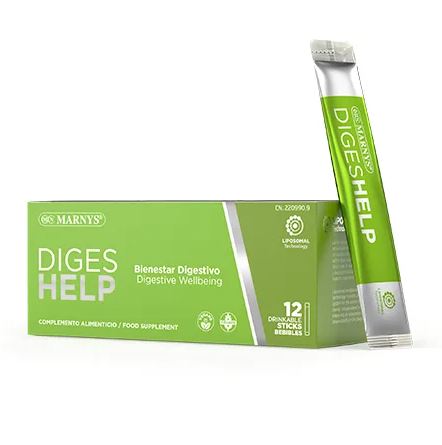? Ask us your questions
Share on social networks
FREQUENTLY ASKED QUESTIONS ABOUT DIGESHELP
TO KNOW MORE
How Our Digestive System Works
Our gastrointestinal tract is vital for life: it is responsible for digesting food, absorbing nutrients, eliminating waste, and protecting us. From the mouth to the anus, each organ has a function.
From the Mouth to the Stomach: Starting the Digestive Process
The digestive process starts in the oral cavity, characterized by the grinding of food by the teeth and saliva, whose action through an enzyme called amylase breaks down carbohydrates. This food bolus, now chewed and moistened, passes through the throat (pharynx) and enters the esophagus. The esophagus is not just a tube; it is a muscle that, through rhythmic contractions (known as peristalsis), pushes the food towards the stomach.
Gastric Digestion: the Stomach as the Food Processor
Upon reaching the stomach, the food bolus mixes with gastric juice, an highly acidic environment (pH 1.5-3.5), due to the secretion of hydrochloric acid that not only kills bacteria but also converts pepsinogen into the enzyme pepsin, which begins to break proteins down into smaller fragments (peptides). The rhythmic contraction of the stomach muscles (gastric motility), aids in the mechanical grinding and mixing, transforming the bolus into chyme.
The Small Intestine: Where Main Nutrient Absorption Occurs
The chyme is gradually released into the duodenum, the first section of the small intestine. Here, the acidic pH is neutralized by the secretion of bicarbonate by the pancreas. In this area, the chyme meets three key assistants:
- Bile: is crucial for breaking down fats into small droplets, facilitating their digestion. The enzymes responsible for this action are the
- Pancreatic juice: this juice is a potent mix of enzymes that digest carbohydrates (amylase), proteins (trypsin and chymotrypsin) and fats (lipases).
- Intestinal enzymes: produced by the walls of the small intestine itself, these enzymes finish breaking down carbohydrates and proteins into their simplest units (sugars and amino acids).
The walls of the small intestine are covered by millions of tiny projections called villi and microvilli. These structures, which look like tiny fingers, greatly increase the surface area for absorption. Through them, the already digested nutrients (sugars, amino acids, fatty acids, vitamins, and minerals) cross the intestinal wall and enter the bloodstream or lymphatic system, ready to be distributed to every cell in your body.
Large Intestine: Water Absorption and Faeces Formation
The material not digested and not absorbed moves into the large intestine. The primary function of this section is the absorption of water and electrolytes, leading to the compaction of faeces. Additionally, in the large intestine live millions of "good" bacteria (the gut microbiota), which help break down some indigestible materials and produce certain essential vitamins (e.g., vitamin K, biotin). Faeces are stored in the rectum before being eliminated by defecation.
In summary, digestion is a finely regulated process that involves the coordinated action of multiple organs, enzymes, and transport mechanisms, ensuring the efficient conversion of food into components usable by each cell in the body.
Common Digestive Problems
When the digestive system isn't working properly, gastrointestinal (GI) disorders arise. These vary in severity and can affect different parts of the digestive tract, causing issues with digesting, absorbing nutrients, or going to the bathroom.
Some common examples include:
- Dyspepsia (Indigestion): discomfort in the upper part of the abdomen, with symptoms such as gas, feeling of fullness, burning, or nausea.
- Gastroesophageal Reflux Disease (GERD): stomach acid rising into the esophagus, causing burning (heartburn), reflux, and difficulty swallowing.
- Nausea and vomiting: feeling like vomiting and the forcible expulsion of stomach contents. Regurgitation is different, without nausea or intense contractions.
- Gas: production of gases (hydrogen, methane, carbon dioxide) that cause belching, bloating, and excessive flatulence.
Refrances
- Andrews PL & Hawthorn J. The neurophysiology of vomiting. Baillieres Clin Gastroenterol. 1988; 2(1): 141-68.
- Azpiroz F. Intestinal gas dynamics: mechanisms and clinical relevance. Gut. 2005; 54(7): 893-5.
- Boron, WF, et al. Medical Physiology, Edition 3. 2016.
- Hall JE & Hall ME. Guyton and Hall Textbook of Medical Physiology, 14th 2021
- Katz PO, et al. ACG Clinical Guideline for the Diagnosis and Management of Gastroesophageal Reflux Disease. Am J Gastroenterol. 2022; 117(1): 27-56
- Talley NJ. Functional Dyspepsia: Advances in Diagnosis and Therapy. Gut Liver. 2017 May 15;11(3):349-357.
- Your Digestive System & How it Works. [Internet]. Bestheda: NIH Natrional Institute of Diabetes and Digestive and kidney diseases; [Updated Dec 2017; consulted May 2025]. Available at https://www.niddk.nih.gov/health-information/digestive-diseases/digestive-system-how-it-works































Reviews
There are no reviews yet.